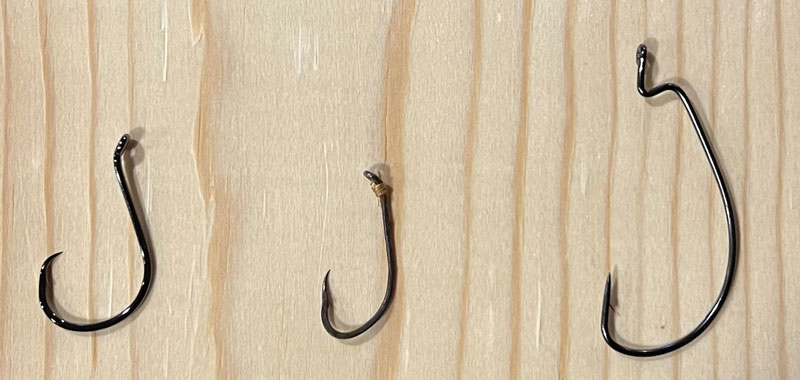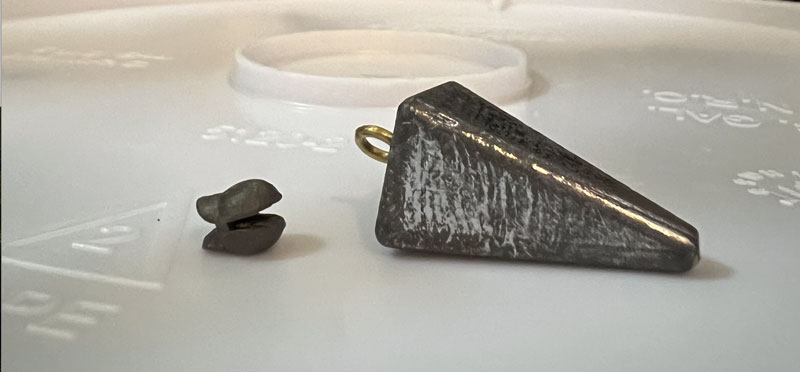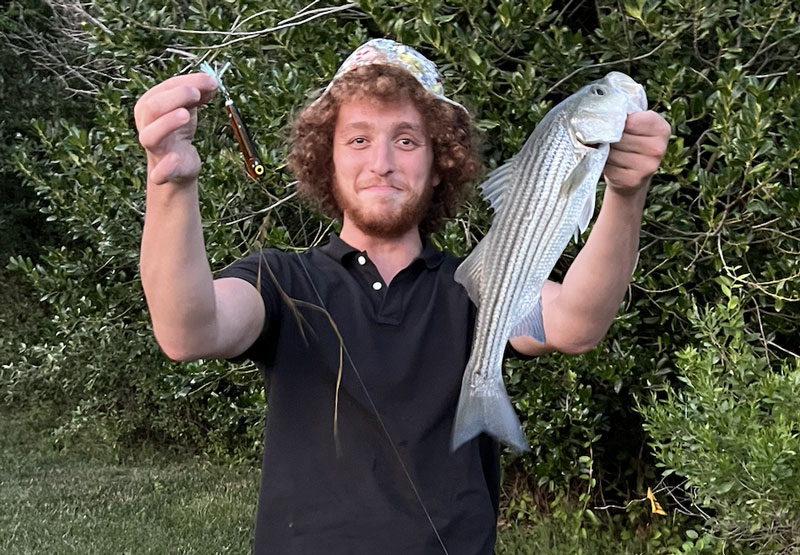If you're just getting started as an angler, whether casting for bass has got you hooked or Chesapeake Bay fishing seems like THE thing, you may be overwhelmed with the enormous amount of tackle and gear in today’s market. Don’t let the start of your fishing journey be delayed any further. This list, crafted under the assumption that individuals preparing their first tackle box already have a rod and reel spooled up with line, compiles bare-bones techniques, must-have tools, and words of advice for the novice angler.

- Hooks - It’s only fitting that the first item on this list is the one that actually sticks the fish. Hooks can be used to hold bait or soft plastics (see Soft Plastics below). They come in many shapes and sizes, but there are three types that you should focus on for your first tackle box: circle hooks, J hooks, and extra wide gap (EWG) hooks. Circle hooks and J hooks are primarily used with live or cut bait, and you’ll want to get a variety of sizes so you can target anything from a small white perch to a monstrous blue catfish. Just be sure to check your state’s regulations, as fishing in some areas for certain species may ban the use of J hooks with bait and require circle hooks. EWG hooks are for rigging soft plastic lures in a weedless fashion. This technique is great for going after bass or snakehead when the fish are holed up in thick vegetation. Again, it is important to get different sizes to match the profile of your plastic and the species you plan to catch.
- Weights - Weights are used to keep your bait on the bottom and to increase a lure’s fall rate or the depth at which it will run. This is another category with an overwhelming amount of options that can be simplified. When fishing with bait, the type of weight you’ll want to choose is called a sinker. There are a number of shapes and sizes here as well, but the general rule of thumb regarding your weight selection is: in stronger current or deeper water, pick a heavier option. Go lighter in shallow, more slack conditions. Regarding shape, grab yourself some pyramid sinkers. They are the most versatile for bottom fishing with live or cut bait. Another type of weight you should acquire is called a split shot. These small balls of lead are attached directly to the line and work well at keeping your bait on the bottom when fishing with small hooks and tiny offerings for species like trout and bluegill. Split shots can also be employed when using light lures to increase casting distance or swimming depth. Again, get a variety of sizes for different conditions.

A split shot (left) and pyramid sinker (right) are two essential types of weights for your first tackle box. - Bobbers - Watching a bobber dunk below the surface is one of fishing’s greatest thrills. These floats are attached directly to the line and indicate a strike. As with most items on this list, there are a ton of options when it comes to bobbers. Start off with the simple, round, red and white plastic bobbers that you’ve likely seen before. If you want to be able to cast further, get a few that have some weight built in. Affix your bobber one to three feet above a baited hook, and toss it out. If you see it disappear under the water, start cranking and hold on tight.
- Soft Plastics - The first three items on this list have the basics of bait fishing covered, but artificial offerings have their place in a beginner’s first tackle box, too. Right on theme, there are about a million different soft plastic lures to choose from. For simplicity’s sake, let’s focus on just two. Paddletails make the list because they imitate small baitfish, and, well, fish eat other fish. All it takes is casting out and reeling straight back towards you to work this plastic effectively. Once you get the lure moving, the boot-like tail will kick back and forth, imitating prey fleeing from a predator. Make sure to match the size of your bait to the size of the fish you’re trying to catch. A crappie finds a one- or two- inch long minnow an adequate snack, whereas a rockfish will be more inclined to go after a bigger meal, say four to five inches long. Rig your paddletail on a jig head (see Jig Heads, coming up next), tie it onto your line, and it’s ready to go. The second soft plastic lure you should acquire is tailored to America’s favorite fish – the largemouth bass. We are talking about the “stick bait” worm, commonly referred to as the Senko. This bait can be rigged on a jig head, weedless on an EWG hook, or wacky-style with the worm hooked directly through the center. Typically fished slow or pitched into cover, it’s a bass-catching machine. Largemouth are accessible to almost everyone and are a hard-fighting fish that will get beginners hooked for life.
- Jig Heads - A jig head is a lead shape attached to a bare hook. Thread a soft plastic onto a jig head, and you have an extremely versatile and effective lure. Jig heads, just like most other tackle, come in different weights and sizes. And, just as with everything else discussed thus far, match the size of the hook to the size of the fish you plan to catch and the weight of the head to the depth of the water.

Beginner anglers would be wise to acquire a pack of soft plastic paddletails and some jig heads. -
Inline Spinner - Moving onto hard baits, the inline spinner is highly effective and easy to fish. These lures come in all sizes so you can target anything from crappie to musky. The blades of a spinner create flash and vibration in the water, mimicking your target species’ favorite prey. Simply cast it out and reel back in.
-
Topwater Popper - There is nothing more exhilarating than watching a rockfish blast out of the water and attack a lure on the surface. A popper is a topwater lure that has a cupped mouth, allowing it to spit water and make a commotion as it’s retrieved. Fishing a popper takes just a bit of practice, but after catching your first topwater fish, you’ll be glad this one made the list. Cast out, and let it sit for a few seconds. Then twitch your rod tip to make the lure pop in the water, and reel up the slack. Twitch again, reel up the slack. You get the idea. Fish a popper as fast or as slow as you want (oftentimes the fish will decide what speed is most effective, not you!) and get ready for the most exciting bites in fishing.

Ethan proudly displays his first topwater rockfish and the popper that did the job. -
Multitool - Unless you plan on sticking your hand into a mouthful of razor sharp bluefish teeth to get your lure back, I’d add a multitool to your list. One with needle-nose pliers will allow you to remove hooks from a fish’s mouth with ease. A knife is also a necessary feature, as you’ll need something to cut bait or line.
-
Ruler or Tape Measure - You probably know that there are limits on the number and size of fish you can keep. So, having a tool handy to measure the fish you plan to put in the cooler will prevent you from guessing whether or not your prize is legal. Head over to the Department of Natural Resources website to check your local regulations.
-
Fishing License - This is perhaps the most important item on this list. Fishing without a license is a misdemeanor and comes with a hefty fine. The best practice is to keep it in a place of easy access, like your tackle box, in case you are asked by an officer to present your documentation. You can also store it digitally on your phone. Licenses can be acquired through the state website for whichever jourisdiction you’ll be fishing in. Not only is it important to practice fishing within the law, but the money you pay to purchase a fishing license goes towards conservation. So, do your part in contributing to the health and prosperity of the waters we all love to fish by grabbing a fishing license for your first tackle box.
- By Adam Greenberg